|
|
|
Manifest Technology Blog
-- Site:
| Articles
| Galleries
| Resources
| DVI Tech
| About
| Site Map
|
Articles:
| PC Video
| Web Media
| DVD & CD
| Portable Media
| Digital Imaging
| Wireless Media
| Home Media
| Tech & Society
|
PC Video: |
PC Video Articles |
Video Software Gallery |
Video Editing Resources |
The Rich Media Web Experience:
Interactive 3D (2/2002)
by Douglas Dixon
Viewpoint Corp.
Capabilities - Technology
Macromedia - Flash and Shockwave
Capabilities - Technology
Rich Media
References
In the beginning of the Web, simply clicking through pages was amazing --
viewing text and graphics, and using interactive hotlinks to surf around the
world. Since then the web has gotten flashier, with animated GIF graphics and
even streaming video. But the promise of the Web has been restricted by
real-world constraints: cool visually compelling experiences are hamstrung by
bandwidth limitations, and truly interactive experiences require waiting for
long downloads.


Part of the answer for providing truly dynamic Web experiences has come from
animation and application players like Macromedia Flash and Shockwave (www.macromedia.com).
With this approach, a player engine can be downloaded once, or even built in to
the browser, so files created in that format can be much smaller and downloaded
significantly faster. These players also can use more efficient formats. For
example, Flash animations are based on vector graphics objects, lines and
shapes, significantly reducing download times by sending just drawing
coordinates and attributes instead of the tens of thousands of pixel values in
huge image files.
The quest for an even better answer for presenting compelling visual and
interactive experiences, with reasonable download sizes, also has been focused
on the promise of 3D objects. With a 3D approach, you could explore an object
like a laptop or a car by simply downloading its 3D geometric model once, and
then have full control of it as you spin it around to look at it, zoom in closer
to see details, and even open it up to look inside. This is much faster, and
much more interactive, then trying to click through lots of images of different
views of an object, or attempting to seek around in a streaming video tour.
With the stunning performance and graphics capabilities of even today's
consumer PCs, recent developments by Macromedia and Viewpoint demonstrate that
the promise of 3D is being realized as a mass-market approach for Web
visualization and interactivity. Both of these products can be used to create
multimedia experiences, combining 3D with traditional Web content, animation,
and video. Macromedia has teamed with Intel to add 3D support to its Shockwave
player and Director 8.5 Shockwave Studio authoring tool. Viewpoint's player is
now bundled with the AOL 7.0 release from October 2001, and in use by sites from
Sony to Eddie Bauer to allow consumers to explore and interact with products
over the Web.
Viewpoint Corporation provides technology and services for rich media Web
experiences (www.viewpoint.com). By
combining efficient 3D models and on-demand delivery of needed detail, the
Viewpoint Media Player can provide highly interactive experiences within the
constraints of today's Web bandwidth limitations.

Delivered though Web browsers using the Viewpoint Media Player, the result is
Web pages that come to life: You can watch a small car drive around within a
banner ad, and then explode out of the browser window to take a spin around your
desktop. Viewpoint also allows much deeper interactions with components on Web
pages: you can lift up a backpack to look at it in more detail, zoom in closer,
and spin it around to see the back side. You can also click on an image to zoom
in to more detail, and have it pop up on top of the Web page, and then click
again and again to zoom in to finer and finer detail, or pan within a much
larger image.
Viewpoint is focused on applications of rich media for e-business
applications from e-commerce to advertising, but some of the most interesting
applications are in providing "hands-on" interaction with products for
marketing over the Web. See the Gallery Showcase section of the Viewpoint web
site for examples in the automotive, electronics & computers, medical, real
estate, retail, and consumer products industries. Companies that have used
Viewpoint to demonstrate products interactively, include Nike shoes and sports
apparel, Eddie Bower backpacks, outdoor tools, and furniture, Sony recording
equipment, AIBO robot dog, Vaio laptops, and computer peripherals, Sharper Image
home products and scooters, Luis Vuitton handbags, and even Godiva chocolates.
The Viewpoint Media Player is a free download for Web users. Viewpoint also
does not charge for its authoring tools, instead it licenses the right to
broadcast content in VET formats. Free licenses are available for non-commercial
educational, student, and hobbyist uses. Small business licenses start at $1500
per year. ZoomView images are licensed separately, starting at $500 per year for
up to 25 images.
Viewpoint licenses its Viewpoint Experience Technology (VET) components to
Web sites, including the HyperView technology to allow rich media to pop out of
the Web page onto the desktop, and the ZoomView technology for exploring still
images in finer and finer detail.
The Viewpoint Media Player supports the full range of rich media formats,
including graphics and text, video and audio, Flash animation, zoomable 2D
graphics, and 3D models, all interacting in the same environment. All these
components are integrated in the same window; there are no sub-frames or borders
around different types of media, and, for example, Flash animation can pass in
front of or behind 3D objects. You can also interact directly with the objects,
turning a 3D model or panning in an image, or the developer can provide buttons
and other controls to script the behavior of objects, for example opening up a
3D product model to show its interior.
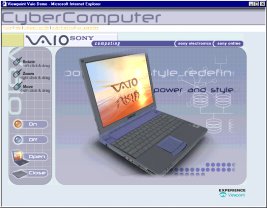 Viewpoint - Flash around 3D Object
Viewpoint - Flash around 3D Object
The HyperView technology is designed to allow rich media to escape the
constraints of small download sizes and limited banner ad space. Instead,
Viewpoint objects can move out of a banner ad, and even out of the Web browser
window, to play the content over any area of the desktop, before retreating back
into the banner space. With HyperView, instead of limiting the interaction to a
small thumbnail figure, or disrupting the user by linking to a different page or
popping open a second window, the object can naturally come "forward"
from the Web page while the user works with it. This is both quite natural and
wonderfully amazing: the first time a car drives out of a small banner ad to
fill your desktop can be quite startling, but interacting with objects this way
is so much more convenient than re-drawing the Web page or bringing up a new
window.
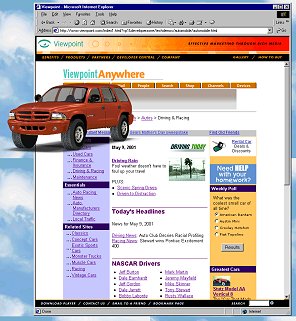 Viewpoint HyperView
Viewpoint HyperView
Similarly, the ZoomView technology allows you to lay out small images as part
of the design of a Web page, with text flowing around them. But, when you click
on an image to see more detail, now it can simply pop up, expanding to a larger
size "in front of" the underlying page. ZoomView images also can be
dynamically refreshed as you explore them; each time you zoom in for more detail
or to pan to the side, the new portion of the image will be incrementally
updated and sharpened as it is downloaded. In this way, you can explore very
high-resolution images even within Web bandwidth limitations, from terrain maps
with road overlays to the finest details of clothing or jewelry.
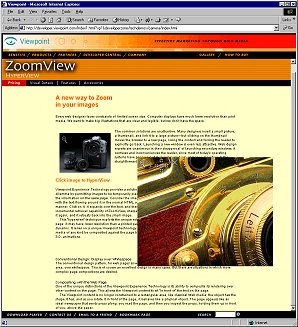 Viewpoint ZoomView
Viewpoint ZoomView
CBSNews.com used ZoomView to provide zoomable digital satellite imagery of
Afghanistan. Viewpoint has also developed the Property Advantage online sales
tool for the real estate industry, to allow potential purchasers to navigate
through interior and exterior views of a property and zoom in for close-ups of
key details.
The Viewpoint 3D technology is designed to create realistic looking objects
and scenes, with bump mapped textures to provide detail to smooth surfaces,
procedural models for dynamically generating plastic, metal, and similar
surfaces, and antialiasing of jagged or blocky edges for a softer and smoother
appearance. The scene description is stored in an XML format to allow it to be
generated on the fly from user input, as individual assets are dynamically
streamed and cached as needed. With this component-based architecture, object
behaviors can be scripted individually, and also controlled externally by the
user or other objects in the scene.
The Viewpoint Media Player also supports scalable multi-resolution playback,
which can provide real-time interaction even when the system performance drops
by dynamically reducing the detail in the scene. But the most powerful, yet
subtle effect in the Viewpoint technology is the use of soft drop shadows.
Viewpoint objects cast shadows, particularly against the background Web page.
The shadow size and color (intensity) is adjusted dynamically, giving a very
natural visual depth cue as an object appears to be floating in space in front
of the background.
Viewpoint encourages the development of content with a variety of free
authoring tools and converters, and extensive technical documentation and
tutorials in the Developer Central section of its web site. Viewpoint authoring
tools include Scene Builder and ZoomView Builder for creating content, and Media
Publisher and Media Embedder for creating Web pages with the content. Over 10
third-party tools feature native export to Viewpoint formats, and Viewpoint also
provides exporters for popular 3D tools including Discreet 3ds max,
Alias|Wavefront Maya, and NewTek Lightwave. It also provides importers for image
panoramas from Apple QuickTime VR and iPIX.
You also can license content from the Viewpoint Digital Assets Catalog, which
contains over 20,000 digital assets, including 3D models, textures, and images,
as well as plug-in and stock motions (see the 3D Model Catalog section of the
web site). Viewpoint also offers professional services for developing 3D and
rich media components, or entire sections, for customer sites. Viewpoint
Creative Services creates 3D models and entire multimedia productions for the
Web, entertainment and game industries, film producers, advertising agencies,
and commercial production houses.
Macromedia's Flash and Shockwave tools provide two different approaches to
designing and delivering animated and interactive Web content. Flash is a
lightweight player for animated vector (object-based) graphics, designed for Web
site front-end splash screens, interactive online advertising such as banner
ads, and short-form to long-form animations. According to Macromedia, the Flash
Player is nearly ubiquitous across the Web, already pre-installed or downloaded
to over 97% of Web users (386 million of the estimated 397 million Web users as
of September 2001).

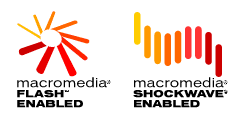
Shockwave is a more sophisticated player, designed for Web content such as
high-performance multi-user games, interactive product demonstrations, online
entertainment, and online learning and training applications. With the
Macromedia Director Shockwave Studio authoring environment, developers can
program custom applications to be delivered on the Web, CD, DVD and corporate
intranets. Macromedia claims the Shockwave Player is installed on the majority
of the Web, with over 270 million Web users (as of October 2001), expanding by
more than 250,000 installations every day.
With Flash, you design graphical elements and then animate them by scripting
their actions in multiple layers. Director is a much more sophisticated
authoring tool for designing productions: you position Cast members (assets) on
a Stage, animate objects as Sprites with scripted movements and behaviors, and
organize your production on a Score with channels of media moving over time.
Objects can be scripted using built-in behaviors, or programmed using Director's
Lingo language. You also can add interaction between objects and with the user,
and use add-in software modules called Xtras to extend the functionality of
Director. The final production can then be published for playback on different
media, including Shockwave for the Web.
The relative sophistication of Flash and Shockwave is reflected in the prices
of their authoring tools: Flash 5 is $399 (list), while the Director 8.5
Shockwave Studio is $1,199. The associated Players are available as free
downloads for both Macintosh and Windows platforms. There is no additional
royalty or hosting cost for distributing Flash or Shockwave content.
Director and Shockwave also continue to develop as an overall multimedia
environment, supporting and integrating a wide variety of media formats so they
can all be controlled and managed from a single environment. Director 8.5
Shockwave Studio supports bitmaps, text, vectors and sound (including MP3), plus
Macromedia Flash animation, Apple QuickTime video, and streaming RealVideo and
RealAudio. Shockwave also supports dynamically updating Web pages by using XML
to read live content. For shared Web events and games, the Shockwave Multiuser
Server 3 supports multiuser communities for up to 2,000 simultaneous users.
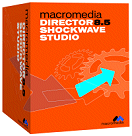
However, the big news with Director 8.5 Shockwave Studio is the addition of
3D support using Intel Internet 3D Graphics software. The goal is to allow
developers to create new types of "magnetic" Web experiences with
highly interactive 3D applications including games, e-merchandizing, e-learning
and product demonstrations, and other interactive, streaming, multiuser
entertainment experiences.
Since Shockwave is widely deployed over the Web, Macromedia is positioning
Shockwave as the standard platform for 3D, so developers can feel comfortable
creating new kinds of applications for this target platform (although it may
require a one-time download as an older version of the Shockwave Player upgrades
itself with the new functionality).
The breadth of applications for Shockwave is demonstrated at the
shockwave.com site, which includes games (arcade, casino, puzzles, multiplayer),
create & send cards and music mixers, and downloads of game collections and
applications. Shockwave.com also merged with Atom Corporation in January 2001 to
create AtomShockwave Corp., as a entertainment provider with game, film, and
animation content.
The Showcase section of the Macromedia web site also includes examples of how
Shockwave is being used. Recent applications of the Shockwave 3D technology
include a Web-based 3D hockey game by CBS SportsLine.com, the Escape sport
utility vehicle by the Ford Motor Company, a NASCAR 3D racing game by
FoxKids.com, a LEGO MINDSTORMS game at LEGO.com, and the Congo Trek 360
exploration at Nationalgeographic.com.
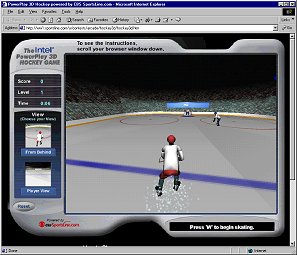 CBS SportsLine game
CBS SportsLine game
The Intel Internet 3D Graphics functionality included in Shockwave provides
advanced graphics features combined with techniques for reducing bandwidth. The
Shockwave system provides streaming of rich media content with built-in
compression. The Player then supports graphics rendering (drawing) that is
optimized for both software-only and hardware-accelerated systems.
Objects can be created with subtle textures and reflective surfaces, and then
placed in a 3D environment with subtle lighting effects. Objects also be drawn
with non-photorealistic shading effects, to look like animated cartoons, pencil
sketches, engravings, and other drawing styles. A particle systems technique can
be used to dynamically generate realistic effects such as smoke, dust, fire,
sparks, water and rain with very low bandwidth overhead.
The movement of 3-D objects can be scripted, as can the object properties and
geometry to change over time. Objects and groups of objects or controlled using
keyframe animation to move smoothly from pose to pose. Characters also can be
created using a skeletal structure with solid bones and flexible muscle and skin
for life-like movement. Plus, the Havok real-time, interactive physics engine
provides game-style play for realistic motion and interactions.
The 3D content can also be defined with scalable geometry, designed for
high-performance PCs, but capable of gracefully reducing to fit reduced
bandwidth and more basic machines. Techniques like multi-resolution meshes and
subdivision surfaces permit 3D designers to design scalability into their 3D
models by providing both high-resolution detail and lower-resolution versions.
Macromedia has also made it easy for developers to continue using popular 3D
design tools and import existing 3D content and formats into Director. Over 40
companies have partnered with Macromedia to support importing content from 3D
authoring tools including Alias|Wavefront Maya, Discreet 3ds max, and Softimage
/ Avid, as well as from libraries of 3D models.
Viewpoint and Macromedia are demonstrating that perhaps the time for 3D on
the Web has finally arrived. Even better, 3D content is not restricted yet
another special plug-in window, but is part of a complete rich media experience,
with text and graphics, audio and video, animation and 3D. For the Web
developer, and the user, this means the palette of content types has grown
larger, resulting in much more compelling experiences are possible within the
constraints of Web bandwidth.
And these rich media productions are interactive, and even multi-user, so you
can control and manipulate objects, whether for hands-on access to products at
an on-line shopping site, or for just-in-time training to understand how to open
up and repair a system, or to explore a virtual world in a multiuser game.
With the widespread availability of Macromedia's Shockwave, and the broad
acceptance of Viewpoint technology by retailers and in AOL 7.0, we can expect to
see even wider exploration of these possibilities.
Macromedia - Shockwave
www.macromedia.com
www.shockwave.com
Viewpoint Corporation
www.viewpoint.com
QuickTime Authoring - QuickTime Pro
www.apple.com/quicktime/authoring
Microsoft Windows Media - Windows Media Player &
tools
www.microsoft.com/windows/windowsmedia
|
